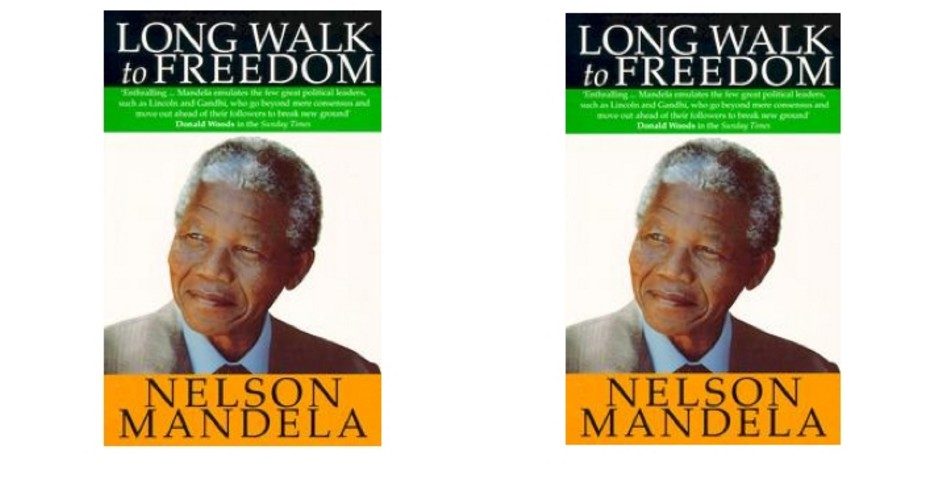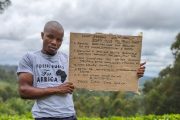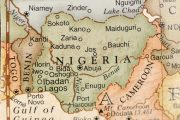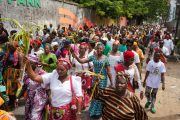
Before being sanitized by a “ghostwriter” who now works in the Obama administration, the recently released original manuscript of South African revolutionary Nelson Mandela’s autobiography exposed the widely celebrated figure as a violent enemy of “democracy.” The first Long Walk to Freedom manuscript also reveals Mandela’s little-known support of violence and terror to advance communism. Largely ignored thus far, the document paints a picture of Mandela that is entirely at odds with the myths of a peace-loving political prisoner propagated by the establishment, communists, and the Western media.
After the revolutionary’s death, the ruling African National Congress and its South African Communist Party coalition partner both released statements officially confirming what had long been suspected by credible analysts. Mandela was not only a communist, he was a member of the Soviet-backed party’s decision-making Central Committee. With the release early this year of the communist leader’s unedited Long Walk to Freedom autobiography, even his most ardent supporters may have trouble defending many of Mandela’s violent and radical views.
“Unquestionably, my sympathies lay with Cuba [during the 1962 Soviet missile crisis],” Mandela wrote in the original, expressing fervent support for one of the most ruthless mass-murdering communist autocracies to ever plague humanity. “The ability of a small state to defend its independence demonstrates in no uncertain terms the superiority of socialism over capitalism.” In another excerpt from the heretofore unreleased version, Mandela said he considered the U.S. brand of “imperialism” to be “the most loathsome and contemptible.”
On the Marxist principle of “dialectical materialism” — a key foundation of every murderous communist regime’s terror — Mandela said: “I embraced it without hesitation.” The newly unveiled document also confirmed again that despite popular myths about Mandela remaining a “peaceful” and “moderate” activist until the 1960 Sharpeville massacre, he had actually been plotting violent revolution since at least 1953, perhaps even earlier.
In his unsanitized memoirs, for example, the revolutionary reveals that he sent a “comrade” to seek weapons and support for the then-officially “non-violent” ANC from the mass-murdering communist regime in Beijing. The original draft also reveals the fact that even Mandela acknowledged that the anti-communist white-led Apartheid government had not isolated, beaten, tortured, or killed a single political detainee until the murderous communist bombing campaigns began in late 1961. Countless innocent civilians were killed in the ANC-SACP terrorist onslaught.
Indeed, to advance communist tyranny, Mandela was more than willing to use violence, as other scrubbed sections from the original manuscript reveal clearly. For instance, Mandela wrote that he felt “ever more strongly” that South African whites needed another “Isandlwana,” a reference to an 1879 battle in which Zulu warriors slaughtered over 1,300 British troops. Incredibly, he seemed to glorify murder and mayhem, writing that soon, “the sweet air will smell of gunfire, elegant buildings will crash down and streets will be splashed with blood.”
Even more alarming, perhaps, is Mandela’s open endorsement of violence against those who opposed his communist revolution — even fellow black Africans, many thousands of whom were tortured and executed by the ANC for standing in the way of Soviet-backed revolution. “If force will advance [the struggle], then it must be used whether or not the majority agrees with us,” Mandela wrote in the original, a notion that analysts compared to Stalinism.
In the published version, however, the sanitized autobiography suggests that violence and coercion are only acceptable when a minority is standing in the way. “A minority should not be able to frustrate the will of the majority,” reads the book published in 1994, essentially the opposite of what Mandela actually wrote while in prison.
Nearly all of the most damning sections of Mandela’s manuscript were conveniently, but not surprisingly, scrubbed from the version of the book that was actually published in 1994. The “ghostwriter” who oversaw the historic deception was then-Time magazine “journalist” Rick Stengel, who, also not surprisingly, currently serves as undersecretary for public diplomacy in the Obama administration.
The ghostwriter-turned-Obama official has refused to comment so far on his deception when contacted by a journalist and researcher — also not surprising considering the staggering effect that the deception had. If Americans and Westerners had known the truth at the time, history certainly would have been very different.
Indeed, the sanitized and deceptive version of Long Walk to Freedom helped to transform Mandela in the public mind from a convicted communist terrorist into a “political prisoner” and a global icon adored worldwide as a symbol of non-violent resistance. In reality, of course, Mandela could have walked out of prison simply by renouncing violence. He refused.
The Hollywood propaganda movie by the same name, based on the bogus book and released last year, helped accelerate the deification of Mandela as a larger-than-life hero peacefully standing against racist oppression. The wild transformation was so thorough that after Mandela’s death, Obama even went to South Africa and compared the communist revolutionary to America’s Founding Fathers.
Early this year, though, the long-missing original manuscript was finally released by the “Nelson Mandela Centre of Memory,” which critics say has played a key role in the Orwellian rewriting of South African history. Unsurprisingly, the Western establishment media, which could not shower enough praises on Mandela over a period of decades, culminating in thousands of worshipful but factually challenged obituaries worldwide late last year, refused to mention the explosive revelations. There has been almost complete silence surrounding Mandela’s now-proven Communist Party leadership, too.
At least one man, though, did highlight the new revelations. Writing in the U.K. Spectator, Afrikaner journalist Rian Malan, who opposed Apartheid, helped blow the lid off of the scrubbed quotes. “By day, he was or pretended to be a moderate democrat, fighting to free his people in the name of values all humans held sacred,” Malan wrote in comparing Mandela’s ghostwritten autobiography to the version that the revolutionary actually wrote while in prison. “But by night he donned the cloak and dagger and became a leader of a fanatical sect known for its attachment to the totalitarian Soviet ideal.”
Other analysts who struggled against Apartheid also had some comments about the revelations. South African activist Sonia Hruska, a former consultant to the Mandela administration who now lives in the United States and works to raise awareness about the grim reality of her homeland and its government, has known something was amiss for many years. “Give credit where credit is due, the ANC played the Mandela card outstanding with the help of the Western liberal community,” she told The New American.
“They were able to hide the dark side, burning their own people and planting bombs to kill innocent civilians, while flaunting the saintly Mandela character,” she continued. “Notwithstanding that he personally gave the orders for the bombings, I doubt if we will ever know how much he was involved with necklacing. One thing is for certain, there is no evidence that he condemned it, neither publicly nor privately.” Necklacing, of course, is the barbaric torture-execution tactic pioneered by the ANC against fellow blacks involving the burning of a gasoline-filled tire around a victim’s neck.
Nelson Mandela, Hruska continued, was a committed communist and even wrote the essay “How to be a good communist.” “The latest surfaced manuscript confirms that inherently, he was not non-violent as he was portrayed so affectionately by the Western media and liberals,” she said. “For 20 years he refused to denounce the brutal murders of the very people he represented, and for the 20 years after the ANC took power, he never condemned the rise of the violent society created by the ANC.”
Another South African working to expose the truth, Harry Booyens, Ph.D., wrote a massive book with meticulous documentation shattering myths about his homeland entitled AmaBhulu — The Birth and Death of the Second America. “In few areas of human endeavor is the selective blindness and deafness of Western media as vividly clear as in the matter of their treatment of Rolihlahla Mandela,” Booyens wrote in his book.
In an e-mail to The New American, Dr. Booyens notes that during his trial, Mandela told the court he was not a communist — and the Western press believed it. “At this point I believe that if Mandela told the New York Times that the Moon was made of cheese, that much quoted newspaper would insist on challenging all the scientists on the planet as to the edible nature of that satellite,” Booyens said, echoing widespread concerns about the Western media’s well-documented failings and deception. The Times, in particular, has a long and sordid history of concealing communist atrocities. Booyens also noted that the press in the West generally continues to help the ANC conceal its crimes, with Mandela’s party seeming not to even care about incriminating itself anymore.
Four Americans in particular, though, were “positioned at the logical root of the entire South African disaster,” Booyens said. Among them: Robert Kennedy, who “inappropriately linked South Africa’s problems of Clashing Civilizations with America’s Civil Rights and Jim Crow issues;” Sen. Dick Clark, who got an amendment passed that “completely destabilized the Southern African situation;” and Randall Robinson, “who built up Desmond Tutu to a level of Godlike status in the United States and inflamed the U.S. public opinion until the U.S. effectively declared economic war on South Africa.”
The final key operative, he said, was Richard Stengel, the current senior-level Obama official who “massaged” Mandela’s biography “to make it palatable to Americans and expunge Mandela’s real convictions on and leadership in matters of Communism.” Stengel, Booyens continued, “must have known full well those convictions would have sunk both the book and Mandela like a lead balloon. This gave the murderous live-human-torching ANC a ‘messianic’ figurehead and made them somehow acceptable to America.”
“Perhaps Stengel thought he was doing some or other great deed, but what he did was to legitimize a terrorist organization to Americans,” Booyens continued, linking Stengel’s machinations to the overlooking of the U.S. government’s “correct” designation of Mandela and the ANC as terrorists, where they remained until 2008. “Mandela is dead. The ANC is not. The broken bodies of more than 3,000 dead white farmers testify to this.”
Alex Newman, a foreign correspondent for The New American, is currently based in Europe. He can be reached at [email protected].
Follow him on Twitter @ALEXNEWMAN_JOU.
Related articles:
South African Communist Party Admits Mandela’s Leadership Role
New Evidence Shows Mandela Was Senior Communist Party Member
In Death, as in Life, Truth About Mandela Overlooked
South African Communists’ Friends in High Places
Genocide and Communism Threaten South Africa
Socialist International Congress Hosted by ANC Amid Genocide Alert



